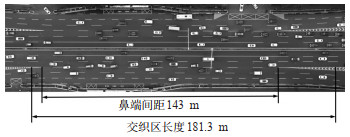An Analysis of the Mechanism of Traffic Conflicts Considering Risky Lane-changing Behavior in Weaving Sections of Expressways
-
摘要: 驾驶人的强行变道行为对交通安全具有较大影响。为研究快速路交织区驾驶人强行变道行为引发交通冲突的机理、提升变道场景的安全性,本研究选取变道收益、变道车辆特征、目标车道后方来车避险特征、交通冲突严重程度4个变量构建了结构方程模型(structural equation model, SEM)。选取南京市1处快速路交织区为研究区域,通过无人机采集200个强行变道行为样本,并从中提取高精度车辆轨迹数据,分析了强行变道行为引发交通冲突的微观机理与关键特征指标。基于最小碰撞时间评估交通冲突的严重程度, 以结构模型分析强行变道各环节因素引发事故风险的因果链路, 提出压迫式、侵入式2种强行变道形态, 综合考虑表征车辆变道收益与变道特征的多项微观指标,建立测量模型。SEM分析表明:变道收益显著影响变道车辆特征(p = 0.044);变道车辆特征显著影响后方来车避险特征(p = 0.001)与交通冲突严重程度(p = 0.021);后方来车避险特征显著影响交通冲突严重程度(p < 0.001)。在变道起始时刻,变道车辆与目标车道后车间距(p = 0.002)、相邻车道前车速度差(p = 0.012)与变道动机(p < 0.001)可以有效表征变道收益; 在变道过程中,驾驶人危险行为特征、车辆横摆角、横向速度均可有效表征变道车辆特征(p < 0.001)。研究结果为微观视角下刻画车辆强行变道风险提供了有效指标,可为车载碰撞预警系统与短距离交织区交通设计提供理论支撑。Abstract: Drivers' risky lane-changing (LC) behavior has remarkable impacts on road safety. To investigate the underlying mechanism of risky LC behavior that contributes to traffic conflicts in expressway weaving sections and further to enhance the safety of LC scenarios, a structural equation model (SEM) is developed in this study incorporating latent variables of LC benefits (LCB), subject vehicle performance features (SVP), evasive features of following vehicle on the target lane (TFVE) and conflict severity (CS). High-precision trajectory data is extracted from 200 samples of risky LC behavior, which are collected by unmanned aerial vehicle (UAV) in an expressway weaving section in Nanjing. The underlying mechanism of risky LC behavior that contributes to traffic conflicts and key indicators of such mechanism are analyzed. The severity of traffic conflicts is evaluated through the minimum time to collision. The causal relationship between LCB, SVP, TFVE and CS are analyzed using the structural model. Two types of risky LC behavior are proposed: the oppressive LC behavior and intrusive LC behavior. Several microscopic indicators characterizing LCB and SVP are adopted to develop the measurement model. Results of the SEM show that, LCB has a significant impact on SVP (p = 0.044), SVP significantly affects TFVE (p = 0.001) and CS (p = 0.021), and TFVE considerably influences CS (p < 0.001). At the beginning of LC behavior, three factors could effectively characterize LCB, which are the distance between the subject vehicle and the following vehicle on the target lane (p = 0.002), the speed difference between the leading vehicles at the adjacent lanes (p = 0.012) and the LC motivation (p < 0.001). During the LC processes, the dangerous driving behavior, the yaw angle and the lateral speed could characterize SVP (p < 0.001) well. This study provides effective indicators for assessing the collision risk of LC behavior from a microscopic perspective, which could be useful for the in-vehicle crash avoidance system and the design of short-distance expressway weaving sections.
-
表 1 原始模型变量描述及统计
Table 1. Description and statistics of variables in initial model
潜变量 显变量 变量解释 均值 标准差 最小值 最大值 比例 变道收益 D1 变道起始时刻SV车尾与TFV车头纵向间距/m 5.67 8.393 -22.12 38 D3-D2 变道起始时刻TLV车尾与LV车尾纵向间距/m -3.531 15.366 -36.25 123.1 V4-V3 变道起始时刻TLV与LV速度差/(m/s) 1.521 3.179 -9.585 8.88 LCBMOM 是否由主路外侧车道进入中间车道(0/1: 否/是) 0 1 101:99 LCBD_MLC MLC车辆变道点与交织区尾端纵向间距(1~5:非常大~非常小) 1 5 138:14:15:14:19 SV变道特征 SVPNSL 是否提前开启转向灯(0/1:是/否) 0 1 69:131 SVPCLC 是否连续变更2条及以上车道(0/1:否/是) 0 1 126:74 SVPSLLC 是否实线变道(0/1:否/是) 0 1 164:36:00 SVPLC_Mode 变道形态(0/1:压迫式/侵入式) 0 1 82:118 D_LC 变道时刻SV车尾与TFV车头纵向间距/m 2.95 4.707 -8.971 22.12 Angle_LC 变道时刻SV的横摆角/rad 0.131 0.098 0 0.611 Angle_Max 冲突过程中SV的最大横摆角/rad 0.172 0.096 0.028 0.649 Acce_Long 冲突过程中SV的最大纵向加速度(m/s2) 0.902 0.751 0 3.205 Dece_Long 冲突过程中SV的最大纵向减速度(m/s2) 1.244 0.998 0 4.6 Acce_Lat 冲突过程中SV的最大横向加速度(m/s2) 0.845 0.615 0 5.31 V_Lat 冲突过程中SV的最大横向速度/(m/s) 0.96 0.46 0.295 3.61 TFV避险特征 Dece_TFV 冲突过程中TFV的最大减速度/(m/s2) 2.724 0.971 0.92 6.57 交通冲突 TTC_Min 冲突过程中最小TTC值/s 1.353 0.518 0.05 2.754 严重程度 D_Min 冲突结尾2车最小间距/m 1.082 0.932 0.08 5.68 表 2 处理后的模型变量描述及统计
Table 2. Description and statistics of variables in modified model
潜变量 显变量 偏度 峰度 变量来源 正态化处理后偏度 正态化处理后峰度 K-S检验p值 变道收益 LCBD1 0.291 1.316 D1离散化 0.291 1.316 0.01 LCBD3-D2 3.5 23.596 ln(D3-D2+45);离散化 0.034 4.73 < 0.001 LCBV4-V3 -0.175 0.204 V4-V3离散化 -0.175 0.204 0.2 LCBMD 2×LCBMOM+ LCBD_MLC SV变道特征 SVPDB SVPNSL +SVPCLC+SVPSLLC+SVPLC_Mode+1 SVPD_LC 1.016 2.144 ln(D_LC+18);离散化 -0.006 1.538 0.041 SVPAngle_LC 1.545 3.53 ln(Angle_LC + 0.035);离散化 -0.028 -0.399 0.2 SVPAngle_Max 1.402 3.173 ln(Angle_Max); 离散化 -0.137 -0.229 0.2 SVPAcce_Long 0.407 -0.644 $\sqrt{Acce\_Long +0.5 }$;离散化 0.025 -1.175 < 0.001 SVPDece_Long 0.871 0.241 $\sqrt{Dece\_Long +0.1 }$;离散化 0.071 -0.666 0.087 SVPAcce_Lat 2.799 14.794 ln(Acce_Lat + 0.2);离散化 0.09 0.837 0.2 SVPV_Lat 1.75 5.792 ln(V_Lat);离散化 0.12 -0.021 0.2 TFV避险特征 TFVEDece 0.863 1.574 ln(Dece_TFV + 1);离散化 0.025 -0.028 0.2 交通冲突 CSTTC_Min 0.128 -0.239 TTC_Min离散化 0.128 -0.239 0.2 严重程度 CSD_Min 2.157 6.167 ln(D_Min);离散化 -0.172 -0.071 0.2 表 3 结构方程模型拟合指标
Table 3. Fitness indices of structural equation model
拟合指标 指标解释 判断准则 拟合值 拟合结果 c2/df(chi-square/degrees of freedom) 卡方自由度比 1 ~ 3 2.663 理想 RMR(root mean square residual) 均方根误差 理想:<0.05
可接受:<0.100.093 可接受 RMSEA(root mean square error of approximation) 近似误差均方根 理想:<0.05
可接受:<0.100.091 可接受 GFI(goodness of fit index) 拟合优度指数 理想:>0.9
可接受:>0.80.915 理想 AGFI(adjusted goodness of fit index) 调整拟合优度指数 理想:>0.9
可接受:>0.80.858 可接受 CFI(comparative fit index) 比较拟合指数 理想:>0.9
可接受:>0.80.863 可接受 表 4 结构方程模型路径分析
Table 4. Path analysis of structural equation model
路径编号 假设路径 标准化路径系数 标准差S.E. 临界比C.R. p value H1 SV变道收益潜变量LCB → SV变道特征潜变量SVP 0.222 0.185 2.010 0.044 H2 SVP→冲突过程中TFV的最大减速度修正变量TFVEDece 0.278 0.22 3.268 0.001 H3 TFVEDece →冲突过程中最小TTC修正变量CSTTC_Min -0.276 0.074 4.006 < 0.001 H4 SVP → CSTTC_Min -0.180 0.215 2.309 0.021 H5 LCB →变道起始时刻SV车尾与TFV车头纵向间距修正变量LCBD1 0.586 0.738 3.050 0.002 H6 LCB →变道起始时刻TLV车头与LV车头纵向间距修正变量LCBD3-D2 0.168 0.274 1.847 0.065 H7 LCB→变道起始时刻TLV与LV速度差修正变量LCBV4-V3 0.934 1.418 2.512 0.012 H8 LCB →变道动机收益组合变量LCBMD 0.237 < 0.001 H9 SVP → SV驾驶人危险行为特征组合变量SVPDB 0.298 0.18 3.439 < 0.001 H10 SVP→ SV变道时刻横摆角修正变量SVPAngle_LC 0.799 0.381 5.608 < 0.001 H11 SVP → SV全过程最大横摆角修正变量SVPAngle_Max 0.950 0.469 5.420 < 0.001 H12 SVP→ SV全过程最大横向速度修正变量SVPV_Lat 0.402 < 0.001 表 5 变道收益变量分布区间
Table 5. Distribution intervals of variables of LC benefits
原始变量 原始变量区间分级 1 2 3 4 5 D1/m ≤-4.8 (-4.8, 2.5] (2.5, 8.5] (8.5, 17] > 17 D3-D2/m ≤-17.61 (-17.61, -8.77] (-8.77, 1.62] (1.62, 13.56] > 13.56 V4-V3/(m/s) ≤ -2.5 (-2.5, 0.2] (0.2, 3.2] (3.2, 6.5] > 6.5 D_MLC/m > 80 (35, 80] (17, 35] (0, 17] =0 表 6 SV动力学指标分布区间
Table 6. Distribution intervals of SV kinetic variables
原始变量 原始变量区间分级 相关性检验(双尾)p值 1 2 3 4 5 TTC_Min ln(D_Min) SVPLC_Mode D_LC/m > 9.66 (4.2, 9.66] (0.17, 4.2] (-1.88, 0.17] ≤-1.88 0.096 < 0.001 0.688 Angle_LC/rad (0, 0.023] (0.023, 0.073] (0.073, 0.154] (0.154, 0.299] > 0.299 0.097 0.581 0.943 Angle_Max/rad (0, 0.067] (0.067, 0.117] (0.117, 0.202] (0.202, 0.317] > 0.317 < 0.001 0.389 0.069 Acce_Long /(m/s2) =0 (0, 0.69] (0.69, 1.32] (1.32, 1.9] > 1.9 0.445 0.13 0.43 Dece_Long /(m/s2) =0 (0, 0.63] (0.63, 1.59] (1.59, 2.86] > 2.86 0.002 < 0.001 0.061 Acce_Lat /(m/s2) (0, 0.34] (0.34, 0.62] (0.62, 1.05] (1.05, 1.62] > 1.62 0.003 0.541 0.003 V_Lat /(m/s) (0, 0.5] (0.5, 0.7] (0.7, 1.07] (1.07, 1.57] > 1.57 < 0.001 0.548 0.101 -
[1] CHEN T, WONG Y D, SHI X, et al. A data-driven feature learning approach based on Copula-Bayesian network and its application in comparative investigation on risky lane-changing and car-following maneuvers[J]. Accident Analysis & Prevention, 2021(154): 106061. [2] YURTSEVER E, LIU Y, LAMBERT J, et al. Risky action recognition in lane change video clips using deep spatiotemporal networks with segmentation mask transfer[C]. 2019 IEEE Intelligent Transportation Systems Conference (ITSC), Auckland, New Zealand: IEEE, 2019. [3] MA Y, GU X, YU Y, et al. Identification of contributing factors for driver's perceptual bias of aggressive driving in China[J]. Sustainability, 2021, 13(2): 766. doi: 10.3390/su13020766 [4] WU Y, ABDEL-ATY M, WANG L, et al. Combined connected vehicles and variable speed limit strategies to reduce rear-end crash risk under fog conditions[J]. Journal of Intelligent Transportation Systems, 2020, 24(5): 494-513. doi: 10.1080/15472450.2019.1634560 [5] BAO S, LEBLANC D J, SAYER J R, et al. Heavy-truck drivers' following behavior with intervention of an integrated, in-vehicle crash warning system: A field evaluation[J]. Human Factors, 2012, 54(5): 687-697. doi: 10.1177/0018720812439412 [6] 李林恒, 甘婧, 曲栩, 等. 智能网联环境下基于安全势场理论的车辆换道模型[J]. 中国公路学报, 2021, 34(6): 184-195. https://www.cnki.com.cn/Article/CJFDTOTAL-ZGGL202106018.htmLI L, GAN J, QU X, et al. Lane-changing model based on safety potential field theory under the connected and automated vehicles environment[J]. China Journal of Highway and Transport, 2021, 34(6): 184-195. (in Chinese) https://www.cnki.com.cn/Article/CJFDTOTAL-ZGGL202106018.htm [7] WU C, PENG L, HUANG Z, et al. A method of vehicle motion prediction and collision risk assessment with a simulated vehicular cyber physical system[J]. Transportation Research Part C: Emerging Technologies, 2014(47): 179-191. [8] WANG C, SUN Q, FU R, et al. Lane change warning threshold based on driver perception characteristics[J]. Accident Analysis & Prevention, 2018(117): 164-174. [9] BALALE, CHEURL, SARKODIE-GYANT. A binary decision model for discretionary lane changing move based on fuzzy inference system[J]. Transportation Research Part C: Emerging Technologies, 2016(67): 47-61. [10] CHEN T, SHI X, WONG Y D. A lane-changing risk profile analysis method based on time-series clustering[J]. Physica A: Statistical Mechanics and its Applications, 2021(565): 125567. [11] CHEN T, SHI X, WONG Y D. Key feature selection and risk prediction for lane-changing behaviors based on vehicles' trajectory data[J]. Accident Analysis & Prevention, 2019(129): 156-169. [12] CHEN Q, GU R, HUANG H, et al. Using vehicular trajectory data to explore risky factors and unobserved heterogeneity during lane-changing[J]. Accident Analysis & Prevention, 2021(151): 105871. [13] KATRAKAZAS C, QUDDUS M, CHEN W H. Anew integrated collision risk assessment methodology for autonomous vehicles[J]. Accident Analysis & Prevention, 2019 (127): 61-79. [14] 薛清文, 蒋愚明, 陆键. 基于轨迹数据的危险驾驶行为识别方法[J]. 中国公路学报, 2020, 3(6): 84-94. https://www.cnki.com.cn/Article/CJFDTOTAL-ZGGL202006009.htmXUE Q, JIANG Y, LU J. Risky driving behavior recognition based on trajectory data[J]. China Journal of Highway and Transport, 2020, 33(6): 84-94. (in Chinese) https://www.cnki.com.cn/Article/CJFDTOTAL-ZGGL202006009.htm [15] TARKO A P. A unifying view on traffic conflicts and their connection with crashes[J]. Accident Analysis & Prevention, 2021(158): 106187. [16] ARUN A, HAQUE M M, BHASKAR A, et al. A systematic mapping review of surrogate safety assessment using traffic conflict techniques[J]. Accident Analysis & Prevention, 2021 (153): 106016. [17] WANG C, XU C, DAI Y. A crash prediction method based on bivariate extreme value theory and video-based vehicle trajectory data[J]. Accident Analysis & Prevention, 2019 (123): 365-373. [18] 何仁, 赵晓聪, 杨奕彬, 等. 基于驾驶人风险响应机制的人机共驾模型[J]. 吉林大学学报(工学版), 2021, 51 (3): 799-809. https://www.cnki.com.cn/Article/CJFDTOTAL-JLGY202103003.htmHE R, ZHAO X, YANG Y, et al. Man-machine shared driving model using risk-response mechanism of human driver[J]. Journal of Jilin University(Engineering and Technology Edition), 2021, 51(3): 799-809. (in Chinese) https://www.cnki.com.cn/Article/CJFDTOTAL-JLGY202103003.htm [19] 《中国公路学报》编辑部. 中国交通工稈学术研究综述·2016[J]. 中国公路学报, 2016, 29(6): 1-161.Editorial Department of China Journal of Hightway and Transport. Review on China's traffic engineering research progress: 2016[J]. China Journal of Highway and Transport, 2016, 29(6): 1-161. (in Chinese) [20] DAVIS G A, HOURDOS J, XIONG H, et al. Outline for a causal model of traffic conflicts and crashes[J]. Accident Analysis & Prevention, 2011, 43(6): 1907-1919. [21] PEARL J. Causality[M]. London: Cambridge University Press, 2009. [22] 戢晓峰, 耿昭师, 普永明, 等. 接入道路对山区双车道公路穿村镇路段事故风险影响[J]. 中国安全科学学报, 2022, 32 (5) : 155-162. https://www.cnki.com.cn/Article/CJFDTOTAL-ZAQK202205023.htmJI X, GENG Z, PU Y, et al. Influence of access roads on accident risks of mountainous two-lane highway passing through villages and towns segments[J]. China Safety Science Journal, 2022, 32(5): 155-162. (in Chinese) https://www.cnki.com.cn/Article/CJFDTOTAL-ZAQK202205023.htm [23] 熊仁江, 赵航, 段梅花等. 山地城市建成环境对居民小汽车拥有影响研究——以贵阳市为例[J]. 交通信息与安全, 2022, 40(5): 169-180. doi: 10.3963/j.jssn.1674-4861.2022.05.018XIONG R, ZHAO H, DUAN M, et al. The effect of the terrain slope of mountainous city on car ownership: a case study of the city of Guiyang[J]. Journal of Transport Information and Safety, 2022, 40(5): 169-180. (in Chinese) doi: 10.3963/j.jssn.1674-4861.2022.05.018 [24] ZHENG Z. Recent developments and research needs in modeling lane changing[J]. Transportation Research Part B : Methodological, 2014(60): 16-32. [25] GUO F, FANG Y. Individual driver risk assessment using naturalistic driving data[J]. Accident Analysis & Prevention, 2013, (61): 3-9. [26] ZHENG Z, XIANG Q, GU X, et al. The influence of individual differences on diverging behavior at the weaving sections of an urban expressway[J]. International Journal of Environmental Research and Public Health, 2021, 18(1): 25. [27] KAPLAN S, PRATO C G. Associating crash avoidance maneuvers with driver attributes and accident characteristics : a mixed logit model approach[J]. Traffic Injury Prevention, 2012, 13(3): 315-326. [28] 吴艳, 温忠麟. 结构方稈建模中的题目打包策略[J]. 心理科学进展, 2011, 19(12): 1859-1867.WU Y, WEN Z. Item parceling strategies in structural equation modeling[J]. Advances in Psychological Science, 2011, 19(12): 1859-1867. (in Chinese) [29] 姚荣涵, 祁文彦, 郭伟伟. 自动驾驶环境下驾驶人接管行为结构方稈模型[J]. 交通运输工稈学报, 2021, 21(2): 209-221. https://www.cnki.com.cn/Article/CJFDTOTAL-JYGC202102021.htmYAO R, QI W, GUO W. Structural equation model of drivers'takeover behaviors in autonomous driving environment[J]. Journal of Traffic and Transportation Engineering, 2021, 21(2): 209-221. (in Chinese) https://www.cnki.com.cn/Article/CJFDTOTAL-JYGC202102021.htm [30] IACOBUCCI D. Structural equations modeling : Fit indices, sample size, and advanced topics[J]. Journal of Consumer Psychology, 2010, 20(1): 90-98. -





 下载:
下载:






